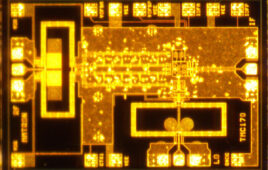 The growing number of devices connected to wireless networks has highlighted the need for innovative solutions to ensure seamless connections. Now, researchers from Nagoya Institute of Technology have introduced a metasurface that can distinguish wireless signals based on both frequency and pulse width. This metasurface can be integrated into antennas to accommodate more devices within the same frequency band, opening avenues for next-generation communication services that demand higher wireless traffic capacity.
The growing number of devices connected to wireless networks has highlighted the need for innovative solutions to ensure seamless connections. Now, researchers from Nagoya Institute of Technology have introduced a metasurface that can distinguish wireless signals based on both frequency and pulse width. This metasurface can be integrated into antennas to accommodate more devices within the same frequency band, opening avenues for next-generation communication services that demand higher wireless traffic capacity.
Recent advances in communication systems, such as the increase in mobile phone users, the adoption of Internet-of-Things devices, and the integration of smart sensors in applications ranging from smart homes to manufacturing have given rise to a surge in wireless traffic. Similar to how a roadway becomes congested with vehicles, the rising wireless traffic is resulting in congestion in the available frequency bands. New frequency bands have been introduced to accommodate more communication signals to operate wireless devices without severe interference with each other.
However, supporting a broad spectrum is challenging. There are only a limited number of frequency bands available. Additionally, it increases the complexity of wireless devices and infrastructure. One possible solution for accommodating signals within existing frequency bands is to tune them in a way that further distinguishes them.
Now, in a new study published in Nature Communications on 3 January 2024, a team of researchers from Japan, led by Associate Professor Hiroki Wakatsuchi from Nagoya Institute of Technology, along with co-authors Ashif Aminulloh Fathnan and Associate Professor Shinya Sugiura of the University of Tokyo, has designed a metasurface that can distinguish wireless signals based on their frequency and pulse width.
In simpler words, metasurfaces are engineered surfaces that can manipulate incident electromagnetic waves to achieve specific modifications leading to the generation of different signals. This ensures that signals are separated and do not interfere with each other, reducing the likelihood of congestion-related issues. These materials can be integrated into radio-frequency devices like antennas and filters to accommodate more users and devices within the same frequency spectrum.
The developed metasurface consists of several unit cells that respond to specific frequencies. By activating multiple unit cells, it becomes capable of handling signals across multiple frequency bands. The metasurface can be thought of as a filter that selectively transmits signals based on specific frequency sequences. The researchers liken this to frequency-hopping, where devices switch frequencies rapidly to avoid interference. However, in this case, the metasurface can be tuned to alter incoming signals based on their frequencies. This property makes it possible to receive and distinguish a variety of signals of different frequencies from wireless devices.
According to the researchers, the number of devices connected to wireless networks per square kilometer is projected to increase from a million in 5G to 10 million in 6G by 2030. This substantial increase will inevitably strain existing frequency bands. However, with their capability to distinguish wireless signals, metasurfaces represent a novel approach to operating numerous Internet-of-things sensors and communication devices without severe interference.
In the long run, this will be important for next-generation communication services, such as autonomous driving, smart factories, digital twins, cyber-physical systems, and behavior recognition systems!





Tell Us What You Think!